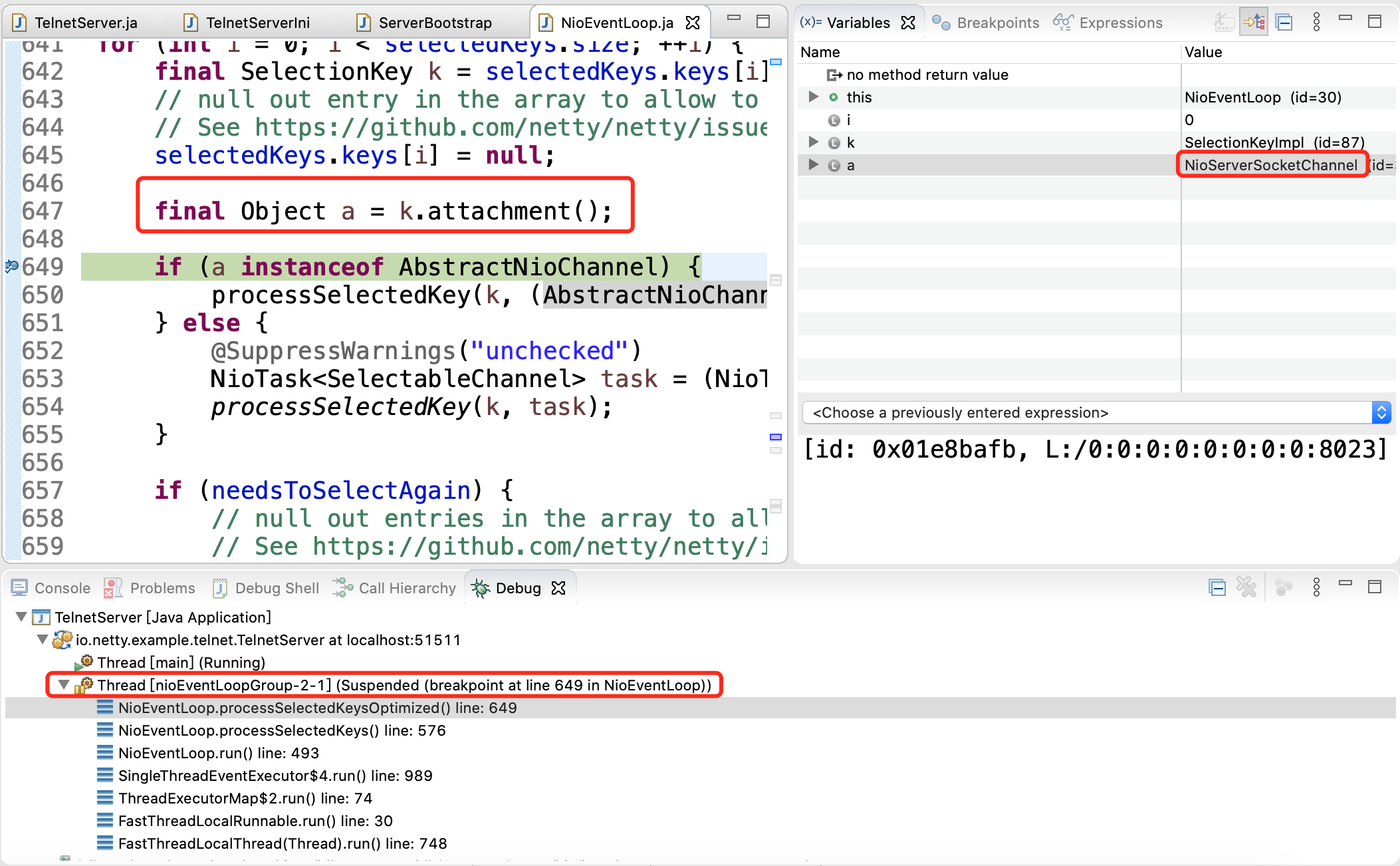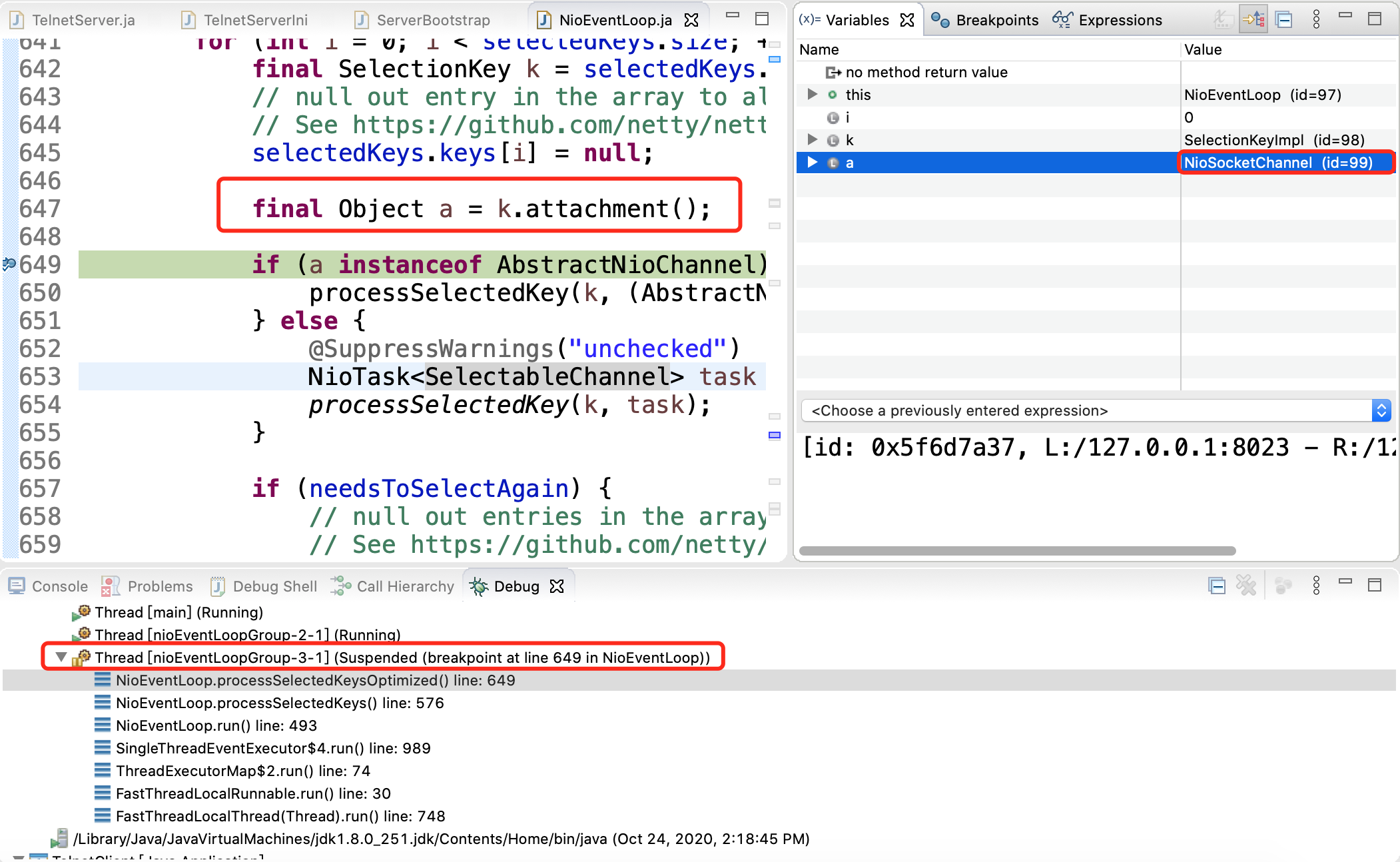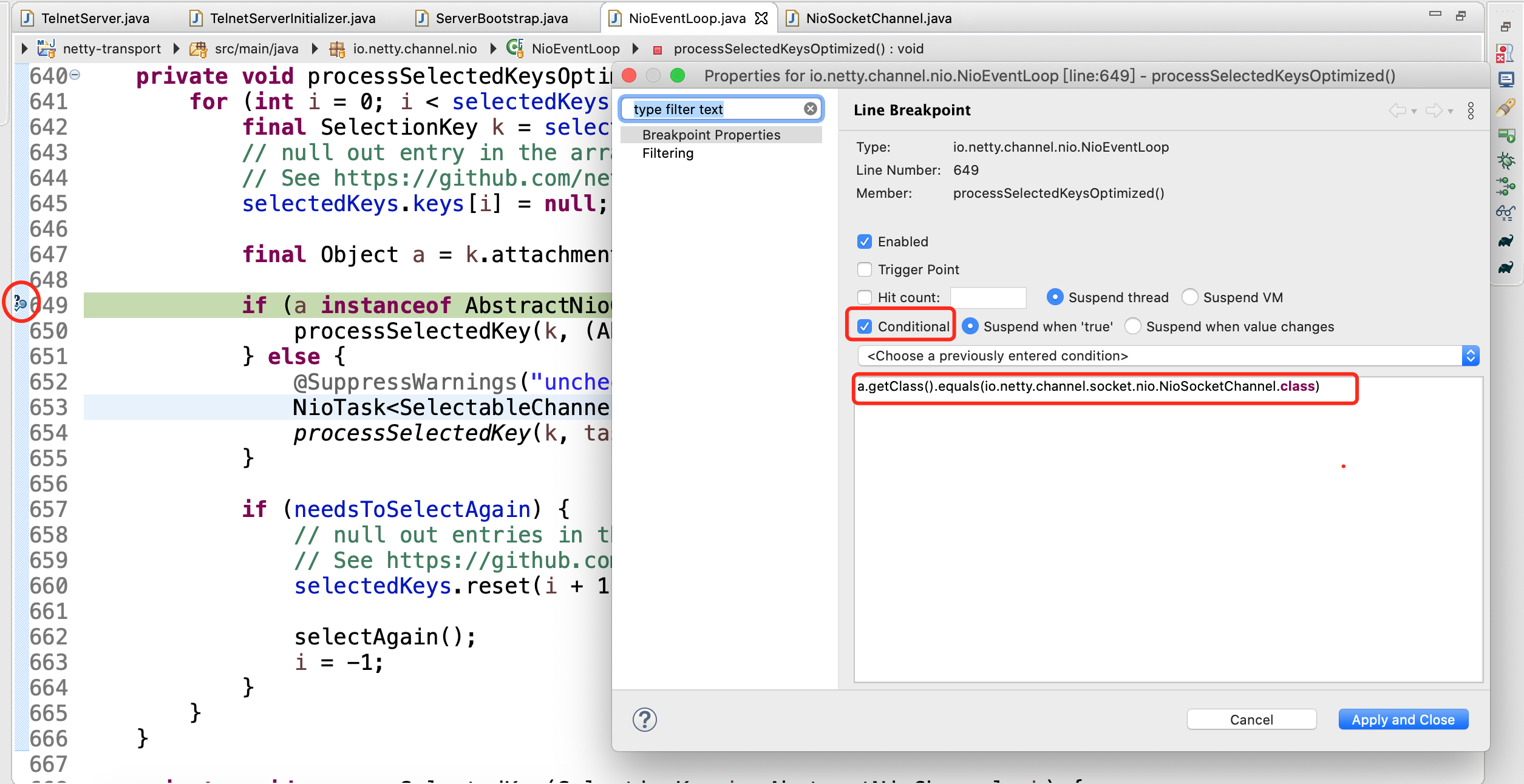(1).Netty又是如何处理读写请求的呢?
代码的入口在:ServerBootstrap$ServerBootstrapAcceptor.channelRead处.
(2).ServerBootstrap$ServerBootstrapAcceptor.channelRead
public void channelRead(ChannelHandlerContext ctx, Object msg) {
final Channel child = (Channel) msg;
// ****************************************************
// 添加childHandler
// ****************************************************
child.pipeline().addLast(childHandler);
setChannelOptions(child, childOptions, logger);
setAttributes(child, childAttrs);
try {
// ****************************************************
// ****************************************************
// ----------------------重点就在于此处------------------
// 由于BossGroup与WorkGroup都属于:NioEventLoop,所以debug有一些难点.
// 在内存中是有存在两个NioEventLoop对象的.
// childGroup(NioEventLoop)注册NioSocketChannel
// ****************************************************
// ****************************************************
childGroup.register(child).addListener(new ChannelFutureListener() {
@Override
public void operationComplete(ChannelFuture future) throws Exception {
if (!future.isSuccess()) {
forceClose(child, future.cause());
}
}
});
} catch (Throwable t) {
forceClose(child, t);
}
} // end
(3).如何debug?
EventLoopGroup bossGroup = new NioEventLoopGroup(1);
EventLoopGroup workerGroup = new NioEventLoopGroup(1);
EventLoop在内存中有两个对象的,所以,断点都是打在NioEventLoop.run方法里.那到底要如何跟踪呢?
可以针对连接和读写分别jstack的跟踪,查看线程的调用链到底是属于BossGroup还是WorkGroup.
在NioEventLoop.processSelectedKeysOptimized方法里,增加条件断点.
如果k.attachment是:NioServerSocketChannel则事件处理是属于:ACCEPT.
如果k.attachment是:NioSocketChannel则事件处理属于:READ/WRITE
设置条件条件表达式为:
[a.getClass().equals(io.netty.channel.socket.nio.NioSocketChannel.class)]



(4).NioEventLoop.run
protected void run() {
int selectCnt = 0;
for (;;) {
// ... ...
try {
// 处理Keys
processSelectedKeys();
} finally {
final long ioTime = System.nanoTime() - ioStartTime;
ranTasks = runAllTasks(ioTime * (100 - ioRatio) / ioRatio);
}
// ... ...
}// end for
} // end run
(5).NioEventLoop.processSelectedKeys
private void processSelectedKeys() {
if (selectedKeys != null) { // true
processSelectedKeysOptimized();
} else {
processSelectedKeysPlain(selector.selectedKeys());
}
}
(6).NioEventLoop.processSelectedKeysOptimized
private void processSelectedKeysOptimized() {
for (int i = 0; i < selectedKeys.size; ++i) {
final SelectionKey k = selectedKeys.keys[i];
selectedKeys.keys[i] = null;
// ********************************************************
// *******************************提示*********************
// NioServerSocketChannel 代表NioEventLoop处理的是ACCEPT事件
// NioSocketChannel 代表NioEventLoop处理的是READ/WRITE事件
// a = NioSocketChannel
// ********************************************************
final Object a = k.attachment();
if (a instanceof AbstractNioChannel) {
// 处理单个key事件
processSelectedKey(k, (AbstractNioChannel) a);
} else {
@SuppressWarnings("unchecked")
NioTask<SelectableChannel> task = (NioTask<SelectableChannel>) a;
processSelectedKey(k, task);
}
if (needsToSelectAgain) {
// null out entries in the array to allow to have it GC'ed once the Channel close
// See https://github.com/netty/netty/issues/2363
selectedKeys.reset(i + 1);
selectAgain();
i = -1;
}
}
} // end processSelectedKeysOptimized
(7).NioEventLoop.processSelectedKey
private void processSelectedKey(SelectionKey k, AbstractNioChannel ch) {
// **************************************************************************
// unsafe = AbstractNioMessageChannel$NioMessageUnsafe 代表NioEventLoop处理的是ACCEPT事件
// unsafe = io.netty.channel.socket.nio.NioSocketChannel$NioSocketChannelUnsafe 代表NioEventLoop处理的是READ/WRITE事件
// 此处unsafe = io.netty.channel.socket.nio.NioSocketChannel$NioSocketChannelUnsafe
// 此:处处理的是Client发送过来的消息("hello world")
// **************************************************************************
final AbstractNioChannel.NioUnsafe unsafe = ch.unsafe();
if (!k.isValid()) { // false
final EventLoop eventLoop;
try {
eventLoop = ch.eventLoop();
} catch (Throwable ignored) {
// If the channel implementation throws an exception because there is no event loop, we ignore this
// because we are only trying to determine if ch is registered to this event loop and thus has authority
// to close ch.
return;
}
// Only close ch if ch is still registered to this EventLoop. ch could have deregistered from the event loop
// and thus the SelectionKey could be cancelled as part of the deregistration process, but the channel is
// still healthy and should not be closed.
// See https://github.com/netty/netty/issues/5125
if (eventLoop == this) {
// close the channel if the key is not valid anymore
unsafe.close(unsafe.voidPromise());
}
return;
}
try {
int readyOps = k.readyOps();
// We first need to call finishConnect() before try to trigger a read(...) or write(...) as otherwise
// the NIO JDK channel implementation may throw a NotYetConnectedException.
if ((readyOps & SelectionKey.OP_CONNECT) != 0) {
// remove OP_CONNECT as otherwise Selector.select(..) will always return without blocking
// See https://github.com/netty/netty/issues/924
int ops = k.interestOps();
ops &= ~SelectionKey.OP_CONNECT;
k.interestOps(ops);
unsafe.finishConnect();
}
// Process OP_WRITE first as we may be able to write some queued buffers and so free memory.
if ((readyOps & SelectionKey.OP_WRITE) != 0) {
// Call forceFlush which will also take care of clear the OP_WRITE once there is nothing left to write
ch.unsafe().forceFlush();
}
// Also check for readOps of 0 to workaround possible JDK bug which may otherwise lead
// to a spin loop
// true
if ((readyOps & (SelectionKey.OP_READ | SelectionKey.OP_ACCEPT)) != 0 || readyOps == 0) {
// unsafe = io.netty.channel.socket.nio.NioSocketChannel$NioSocketChannelUnsafe
// 调用读取消息
unsafe.read();
}
} catch (CancelledKeyException ignored) {
unsafe.close(unsafe.voidPromise());
}
}// end
(8).NioSocketChannel$NioSocketChannelUnsafe.read
public final void read() {
final ChannelConfig config = config();
if (shouldBreakReadReady(config)) { // false
clearReadPending();
return;
} // end if
// DefaultChannelPipeline
// {
// (DelimiterBasedFrameDecoder#0 = io.netty.handler.codec.DelimiterBasedFrameDecoder),
// (StringDecoder#0 = io.netty.handler.codec.string.StringDecoder)
// (StringEncoder#0 = io.netty.handler.codec.string.StringEncoder)
// (TelnetServerHandler#0 = io.netty.example.telnet.TelnetServerHandler)
// }
final ChannelPipeline pipeline = pipeline();
// 获取缓存分配管理器
// allocator = io.netty.buffer.PooledByteBufAllocator
final ByteBufAllocator allocator = config.getAllocator();
// allocHandle = io.netty.channel.AdaptiveRecvByteBufAllocator$HandleImpl
final RecvByteBufAllocator.Handle allocHandle = recvBufAllocHandle();
allocHandle.reset(config);
ByteBuf byteBuf = null;
boolean close = false;
try {
do {
// ******************************************************************
// 创建ByteBuf对象,并从SocketChannel中读取数据到:ByteBuf中
// ******************************************************************
// allocHandle = io.netty.channel.AdaptiveRecvByteBufAllocator$HandleImpl
// 创建一个ByteBuf对象(PooledByteBufAllocator)
byteBuf = allocHandle.allocate(allocator);
// 读取(SocketChannel)数据到ByteBuf中
allocHandle.lastBytesRead(doReadBytes(byteBuf));
if (allocHandle.lastBytesRead() <= 0) {
// nothing was read. release the buffer.
byteBuf.release();
byteBuf = null;
close = allocHandle.lastBytesRead() < 0;
if (close) {
// There is nothing left to read as we received an EOF.
readPending = false;
}
break;
}
allocHandle.incMessagesRead(1);
readPending = false;
pipeline.fireChannelRead(byteBuf);
byteBuf = null;
} while (allocHandle.continueReading());
allocHandle.readComplete();
pipeline.fireChannelReadComplete();
if (close) {
closeOnRead(pipeline);
}
} catch (Throwable t) {
handleReadException(pipeline, byteBuf, t, close, allocHandle);
} finally {
// Check if there is a readPending which was not processed yet.
// This could be for two reasons:
// * The user called Channel.read() or ChannelHandlerContext.read() in channelRead(...) method
// * The user called Channel.read() or ChannelHandlerContext.read() in channelReadComplete(...) method
//
// See https://github.com/netty/netty/issues/2254
if (!readPending && !config.isAutoRead()) {
removeReadOp();
}
}
} // end read
